Where Can I Find Rennet to Make Cheese

This simple homemade rennet cheese recipe is the perfect introduction to cheese making! Rennet cheese can be cultured with either milk kefir or yogurt, so you get all of the probiotic benefits they offer.
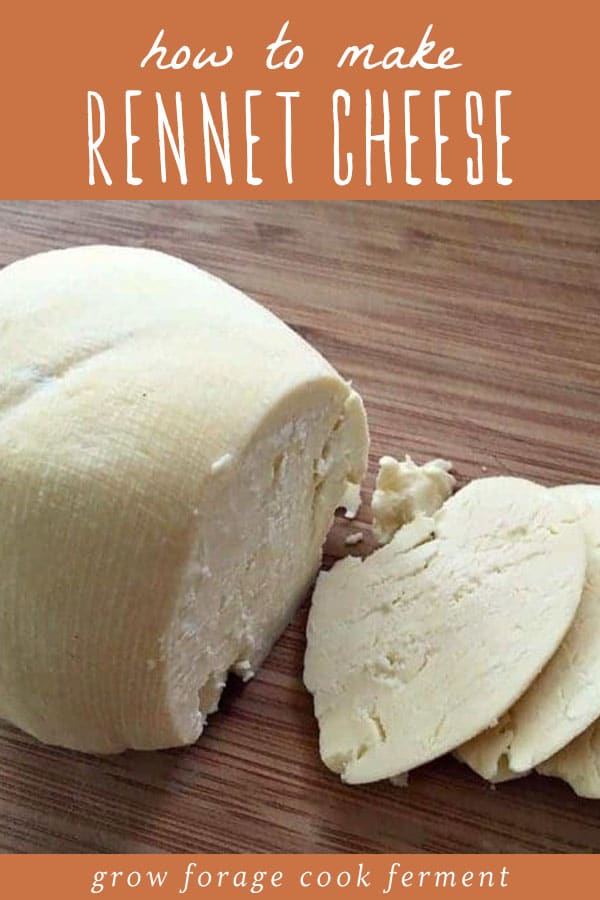
Making Homemade Cheese
Well, I've finally done what I used to think was impossible. I made homemade cheese!
I've been making milk kefir cheese for a while now, and I think it's great, but I've always wanted to make a harder, more slice-able cheese.
I tried several years ago, but it went all wrong, and I've been too scared to try again ever since.
Then I came across this simple rennet cheese recipe in Sandor Katz's book, Wild Fermentation: The Flavor, Nutrition, and Craft of Live-Culture Foods, and it looked so easy I had to give it a try.
The cool part about this cheese is that it can be cultured with either milk kefir or yogurt, so you still get all of the probiotic benefits that they have.
This cheese is not any specific type of cheese, however, as most varieties require specific cultures to make them what they are (cheddar, gouda, etc.).
It's not even a farmer's cheese, as that uses an acid such as vinegar or lemon juice to separate the curds from the whey.
It's just a basic rennet cheese that is easy for beginners to make!
Rennet Cheese Supplies
This simple rennet cheese recipe uses just rennet, and doesn't really require any other special tools or ingredients besides cheesecloth.
I really need to warn you: do not use ultra-pasteurized milk for this recipe.
I have accidentally done this before, and it does not work. Regular pasteurized milk works fine, but many organic milks are now ultra-pasteurized, which is unfortunate.
I did find a grass fed whole milk from Organic Valley that wasn't ultra-pasteurized, but be warned that some of what they carry is, depending on where you live.
Either animal or vegetable rennet will work, so it's your call on that one.
I used a double strength vegetable rennet from Cultures for Health because that's what I had on hand. This vegetable rennet would also work.
Rennet Cheese Recipe
The first thing that you want to do is ripen the milk by adding the milk kefir and/or yogurt to it, then let it sit for an hour or two at around 100°F.
I did this in my Excalibur dehydrator (love that thing!), but you could also leave it on super low heat on the stove, taking it off when necessary so that it doesn't go above 100°F (use a thermometer).
This part of process is optional, but it gives the milk some beneficial cultures so that the cheese will be both tastier and healthier for you.
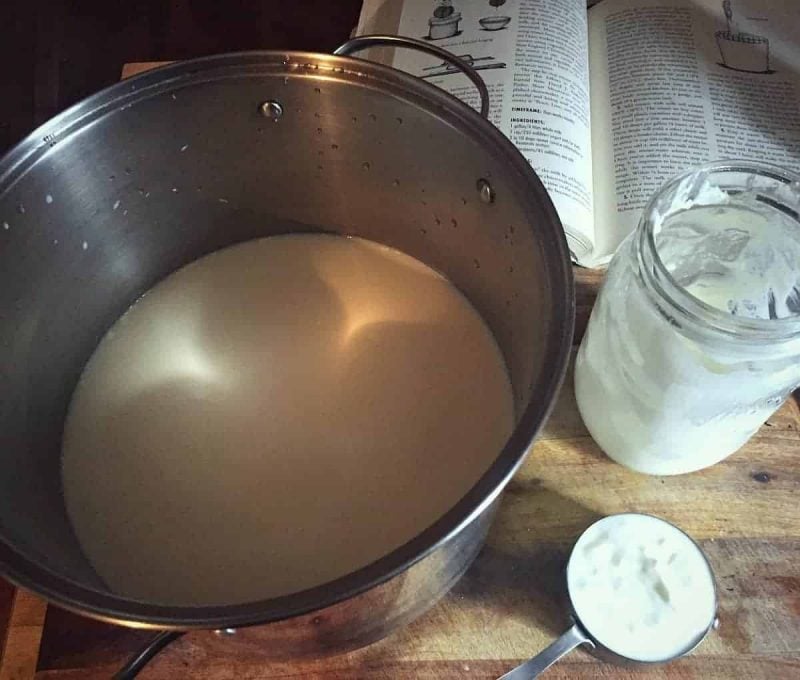
In the meantime, dilute the rennet in about ¼ cup of water. More rennet will result in a harder cheese, so I used about 5 drops, but you can use less for a softer cheese.
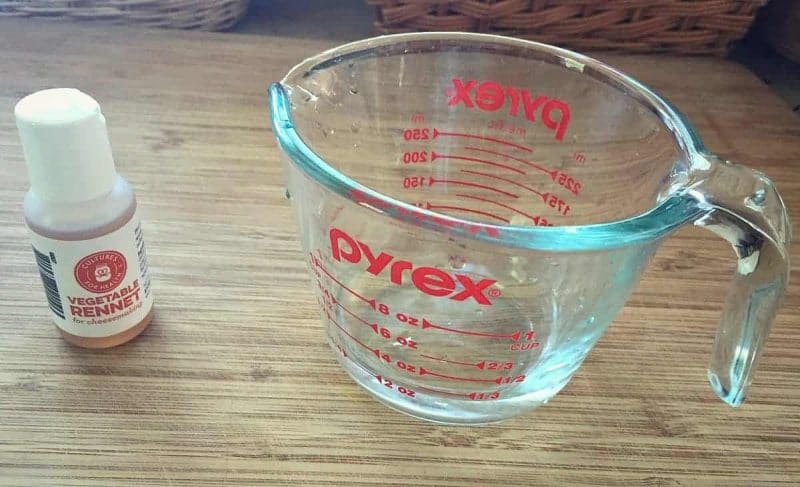
Then, with your milk still at about 100°F, add the rennet mixture slowly while stirring.
As soon as you've added it all, stop stirring. It needs to be still while the rennet does its thing. At this point, turn the burner off if it's still on.
In about 30 minutes, the rennet should have sufficiently coagulated the milk. Turn the heat on low again to gently rewarm the curd, and use a knife to cut it into roughly one inch cubes.
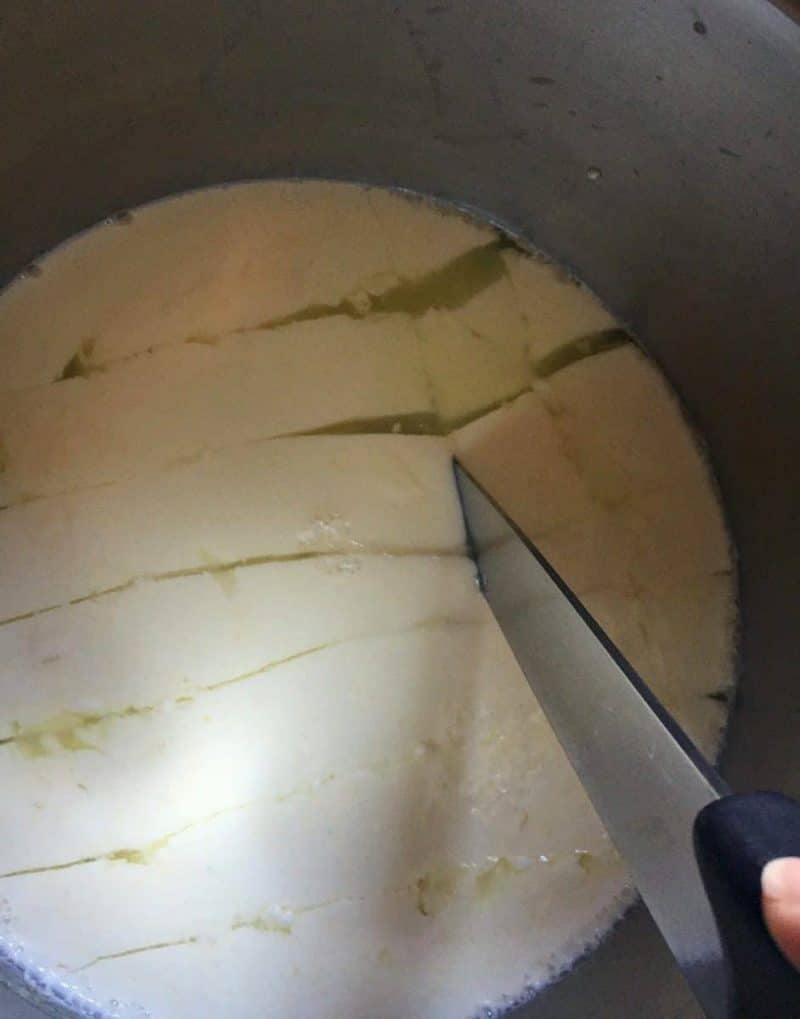
Gently stir the curds, but try not to break them up too much. Keep over low heat, maintaining the 100°F temperature for about 10 minutes for a soft cheese.
For a harder cheese, which is what I was going for, very slowly increase the temperature to no more than 110°F, for 30 minutes to an hour.
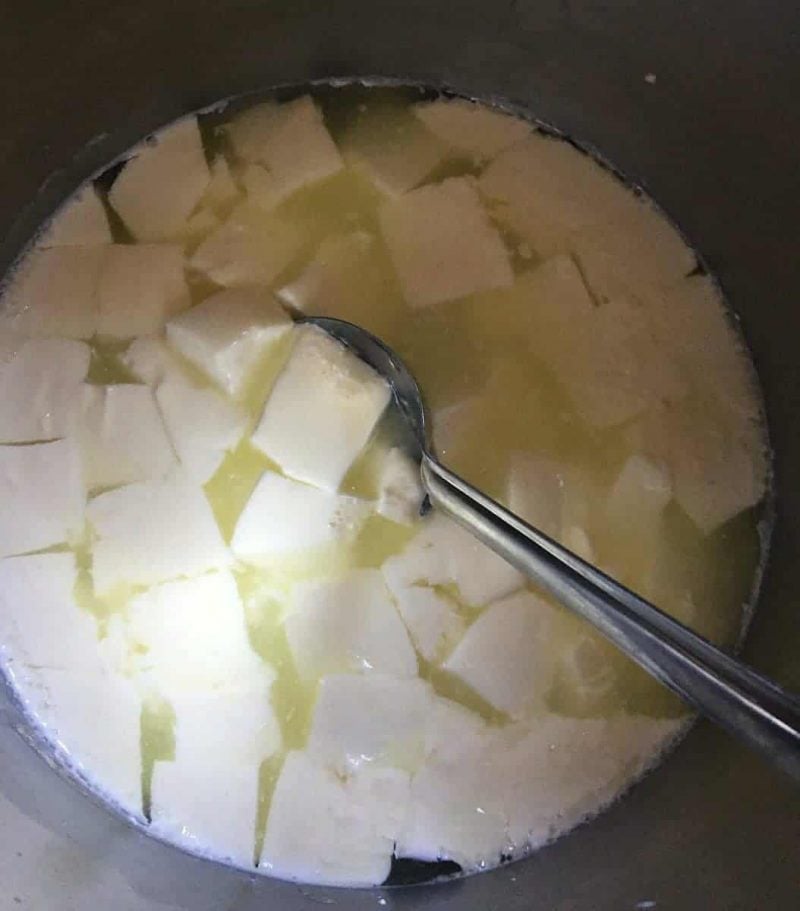
Line a colander with cheesecloth, then gently scoop out the curds with a slotted spoon into it.
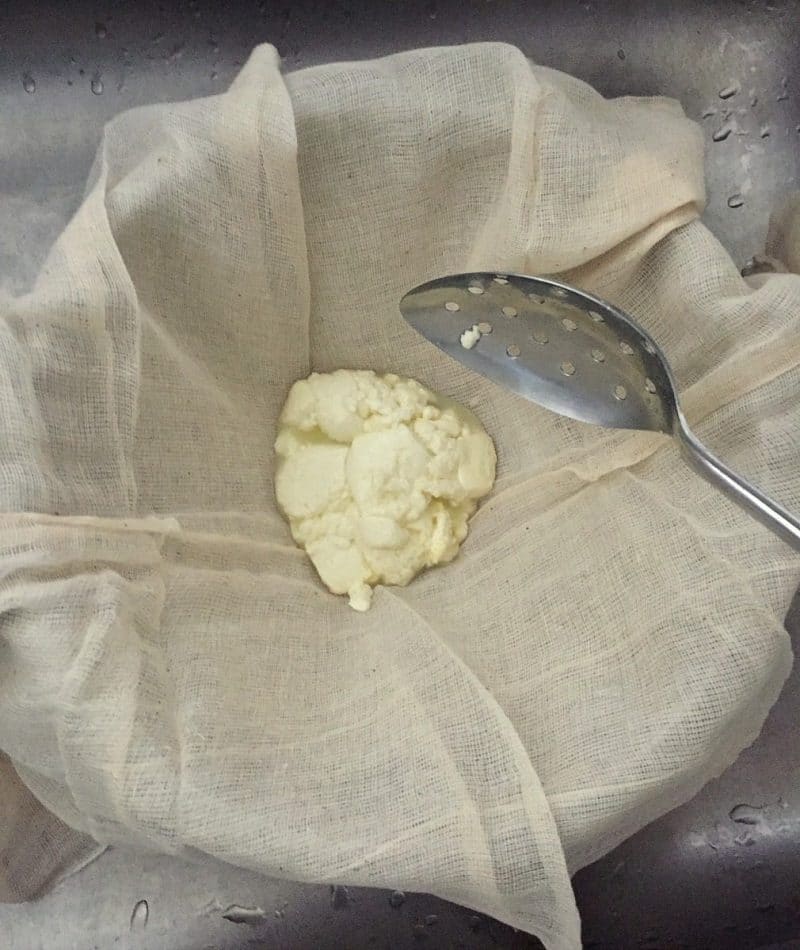
Layer the salt in between the curds. Salt helps to draw out moisture, and much of it will drain off, so don't be afraid to be heavy handed with it.
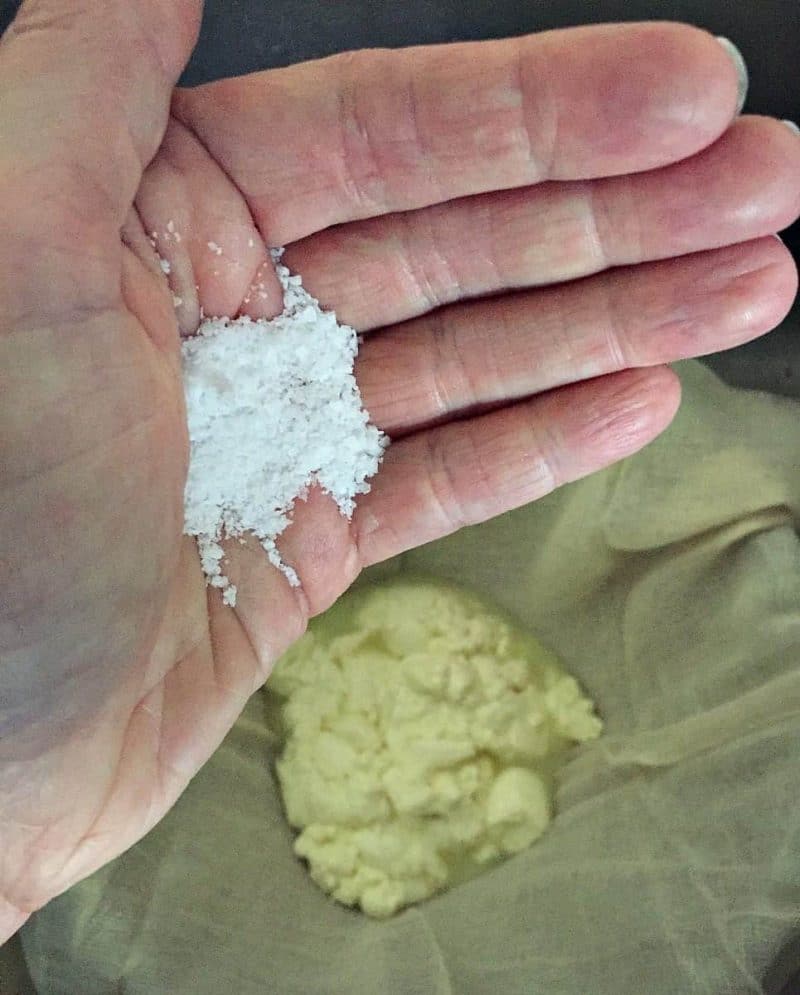
Gather the corners of the cheesecloth together, twist and squeeze the curds into a ball, and force as much of the excess liquid out as you can.
Feel free to save the liquid whey, as it is useful in many ways (16 Uses for Whey from The Prairie Homestead).
Then hang the cheese ball so that it can drip excess whey for about 24 hours. I do this with a wooden spoon over a large pot.
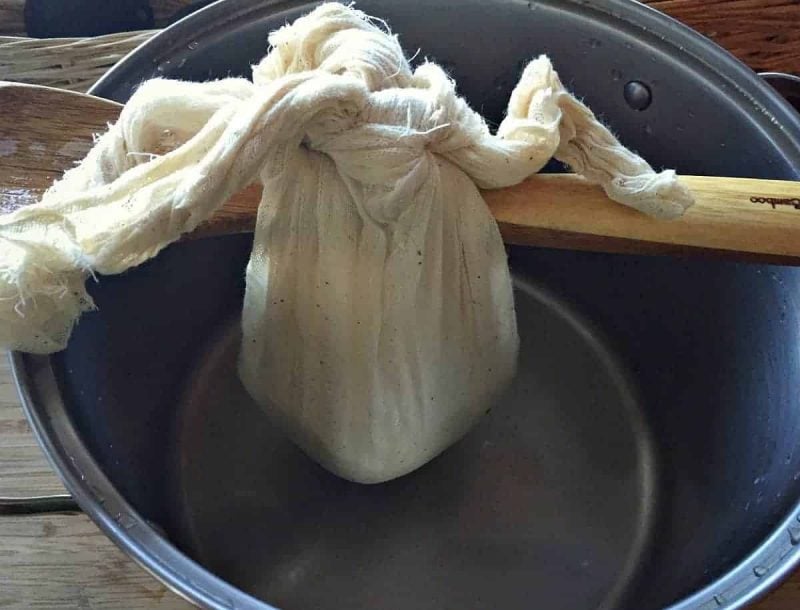
You can by all means eat this cheese right away, but I like to age it for a few more days. It will even start to develop a natural rind.
To do this, re-wrap the cheese daily in a fresh, dry piece of cheesecloth and keep at room temperature, away from flies. The cheesecloth will help to wick any excess moisture away.
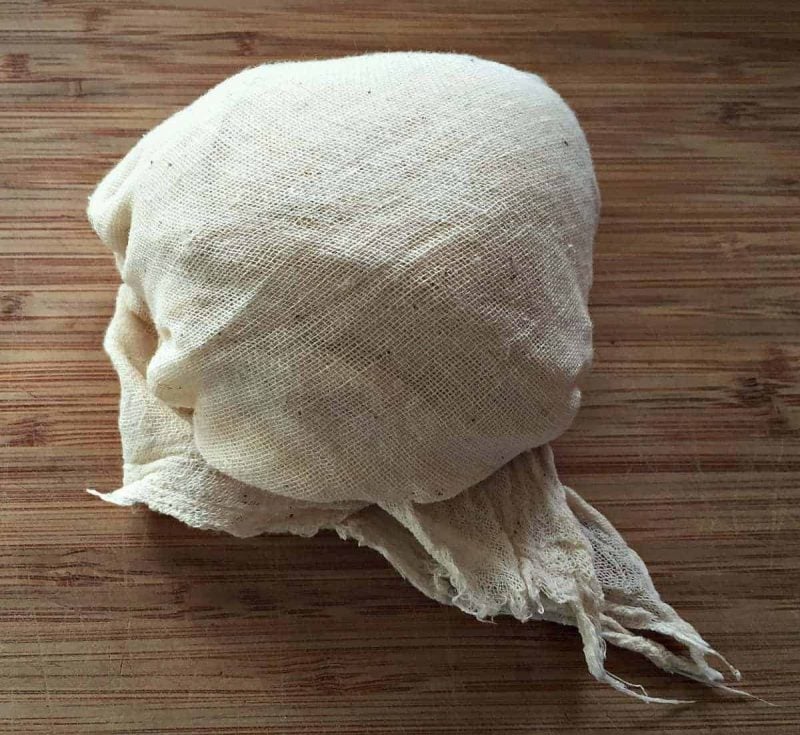
Then, once the cheesecloth is totally dry, you could wax the cheese for longer storage, or just refrigerate it immediately and eat! This took about 5 days for me. I couldn't wait to try my cheese!
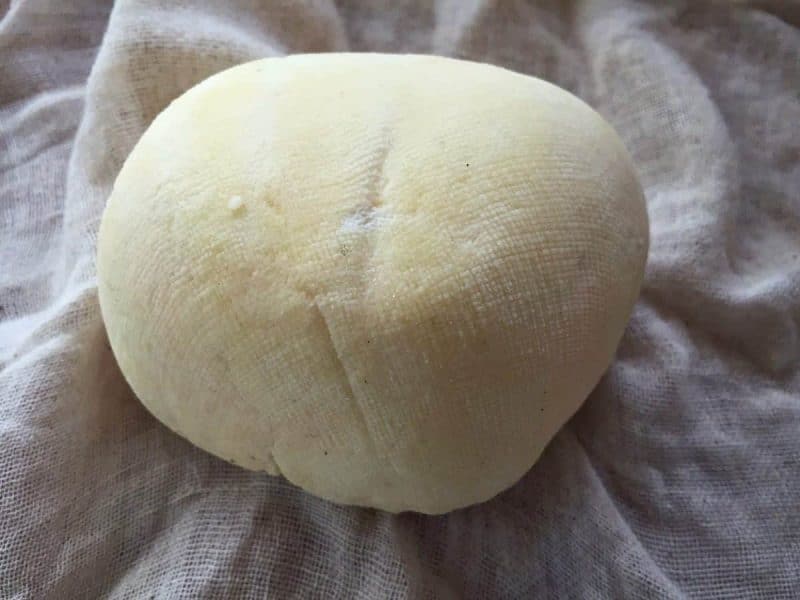
I was nervous that it would be weird or off tasting, but it was absolutely creamy and delicious!
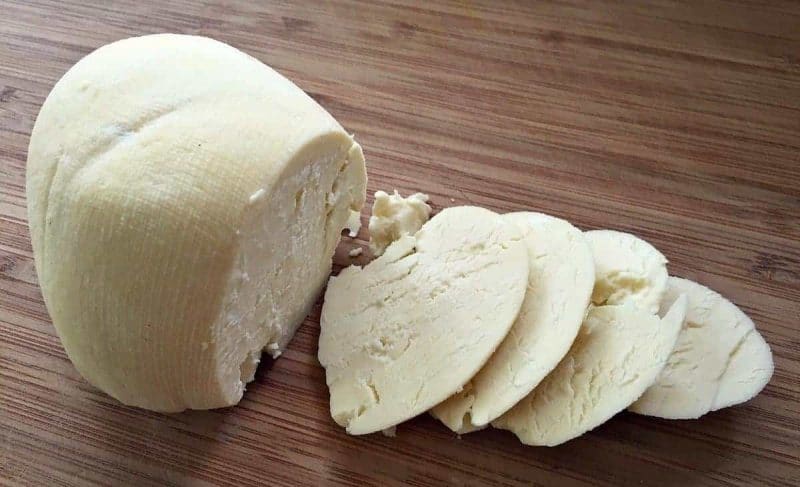
It sliced pretty well and was only the slightest bit crumbly, but it didn't really matter. I was able to melt it on a slice of bread with some corned beef, that's what really matters!
Now that I've gotten my feet wet with cheese making, I'm definitely going to play around with this recipe a bit. It's so easy, yet there are many different variables that can change the final outcome of the cheese.
I may make a double batch next time and wax some of it for longer storage to see how that affects it.
All in all, though, I'm just so excited that I made my own cheese!
Have you ever made your own cheese? How did it turn out? Tell me about it!
Simple Rennet Cheese Recipe
This simple homemade rennet cheese recipe is the perfect introduction to cheese making! Rennet cheese can be cultured with either milk kefir or yogurt, so you get all of the probiotic benefits they offer.
Course Appetizer
Cuisine American
Prep Time 15 minutes
Cook Time 2 hours 30 minutes
Aging 1 day
Total Time 2 hours 45 minutes
Servings 4 cups
Calories 103 kcal
-
Long Bladed Knife
-
Slotted Spoon
- 1/2 gallon whole milk, preferably organic NOT ultra-pasturized
- 1/2 cup milk kefir or yogurt
- 2-5 drops liquid rennet
- 1 1/2 Tbsp kosher salt or sea salt
-
Combine the milk and kefir or yogurt in medium sauce pot. Place the pot into a dehydrator and let it sit for 1-2 hours at 100°F. Alternatively, place it under a very low flame on the stove, taking it off the flame as necessary, to maintain the correct temperature; be sure to use a thermometer.
-
Dilute the rennet in ¼ cup warm water.
-
Remove the pot from the dehydrator if using. Add the rennet mixture slowly while stirring continuously. Stop stirring once you've added all of the rennet. At this point, turn the burner off if it's still on. Let the mixture sit for 30 minutes, until the rennet has sufficiently coagulated the milk.
-
Place the pot back onto the burner and heat on low to gently rewarm the curd. Then use a knife to slice the curd into roughly 1" cubes. Gently stir the curds without breaking them up too much. Continue heating on low with a heat of 100°F for 10 minutes for a soft cheese. For a harder cheese, slowly increase the temperature to 110°F and warm for 30-60 minutes.
-
Line a colander with cheesecloth. Gently scoop out the curds with a slotted spoon and place into the cheesecloth, layering with salt as you go.
-
Gather the corners of the cheesecloth, twist together, and squeeze out the liquid to form a ball. Force out as much excess liquid as possible. Hang the cheeseball above an empty pot (to catch residual whey) for 24 hours.
-
After 24 hours, the cheese can be enjoyed immediately, or further aged for several more days. To continue aging, re-wrap the cheese daily in a fresh, dry piece of cheesecloth and store at room temperature. Once the cheesecloth is completely dry, wax the cheese for longer storage or refrigerate immediately and enjoy.
- Rennet tablets are weaker than liquid rennet and do not work well in many homemade cheese recipes.
Serving: 1 slice | Calories: 103 kcal
Where Can I Find Rennet to Make Cheese
Source: https://www.growforagecookferment.com/simple-rennet-cheese-recipe/